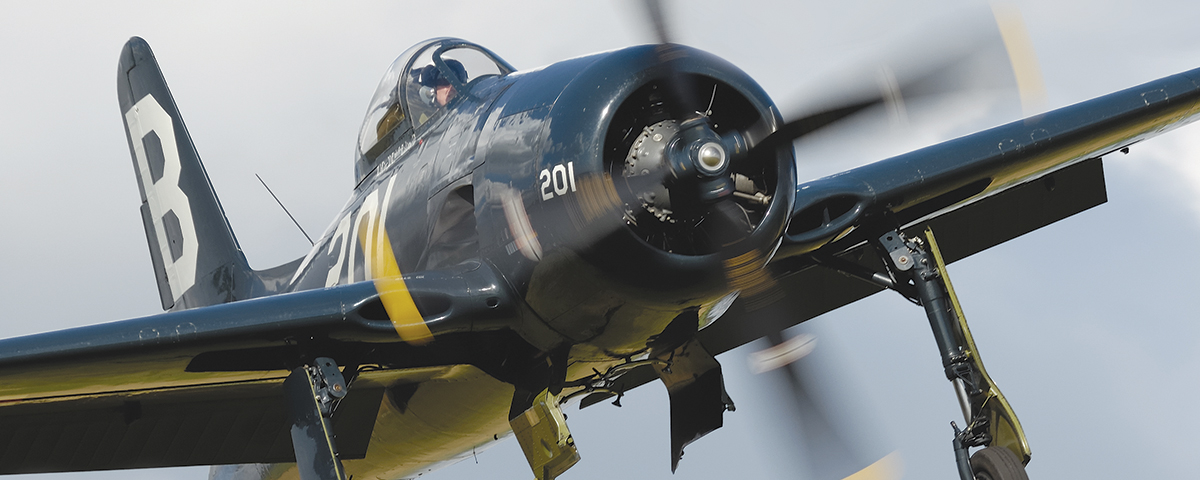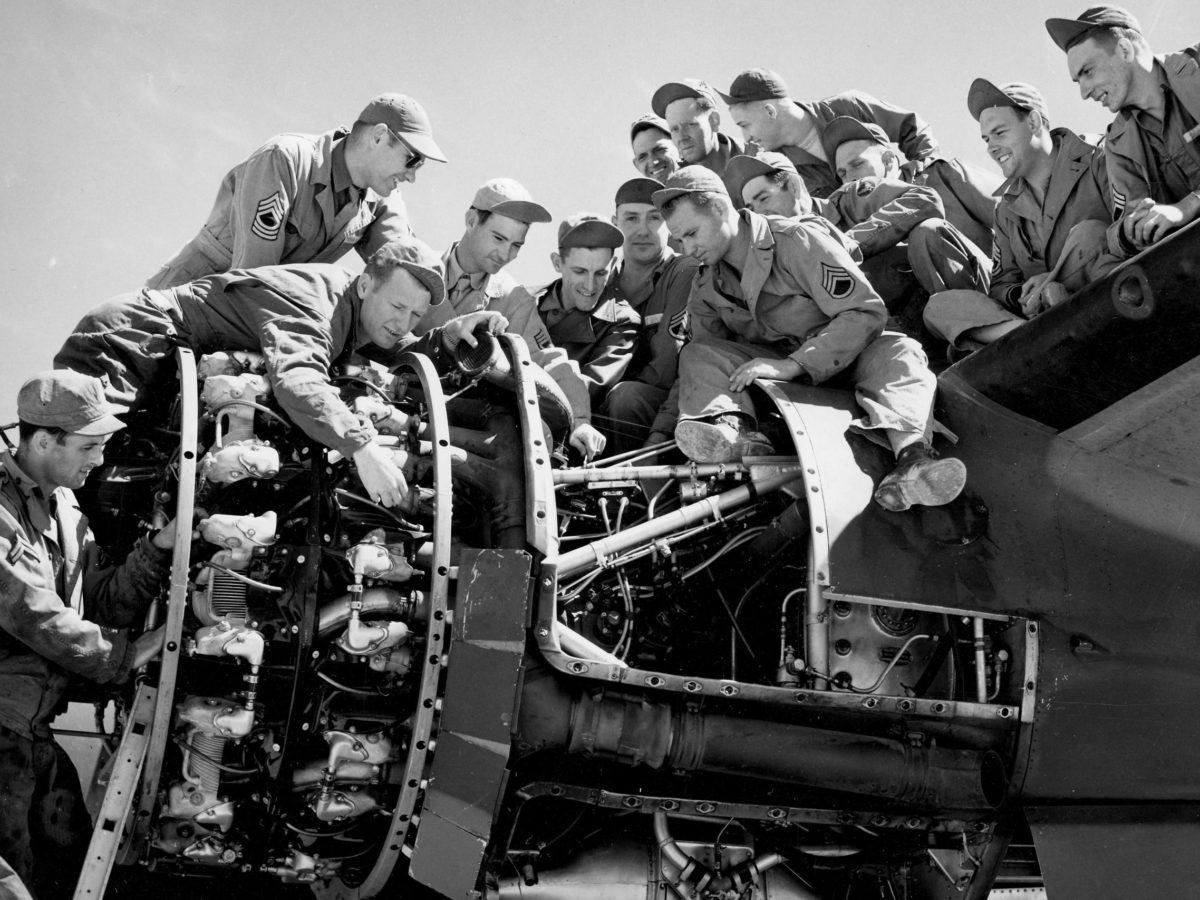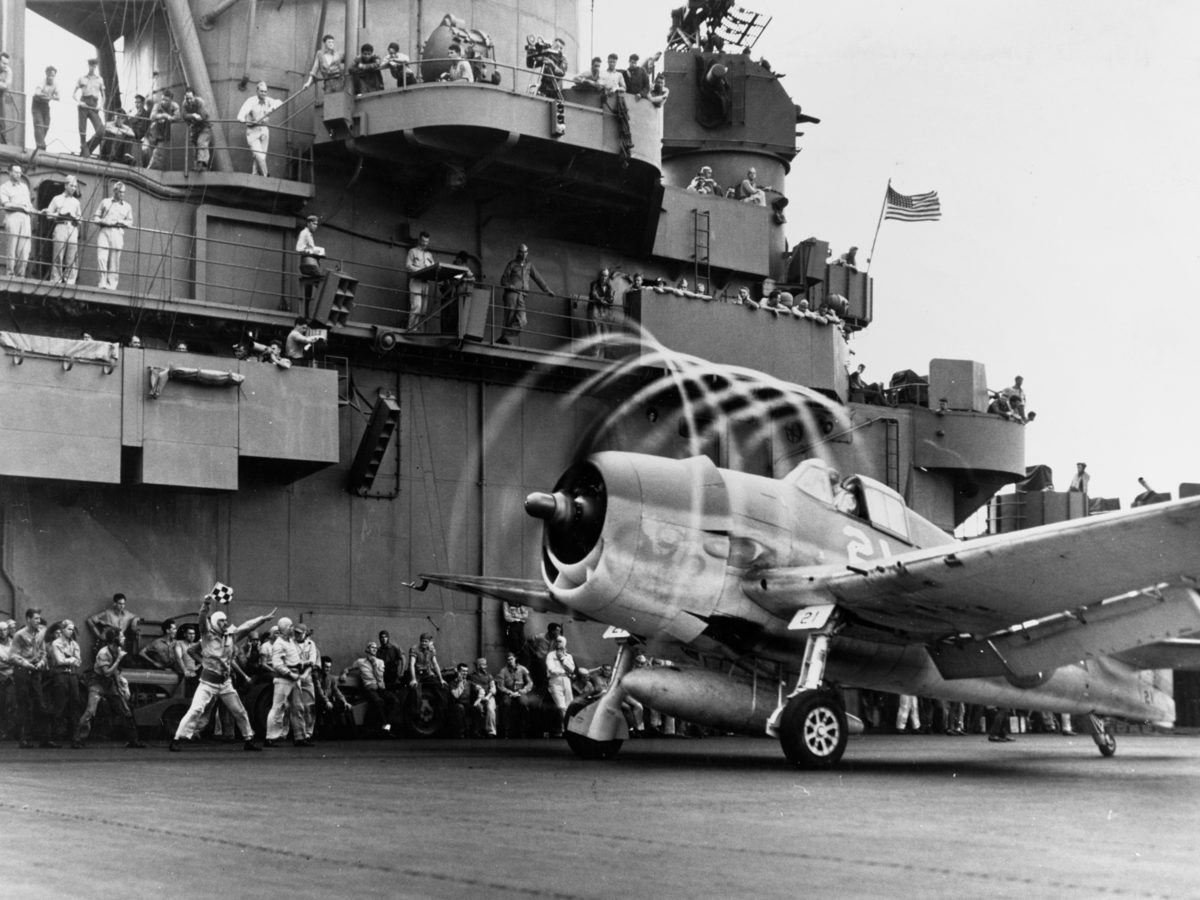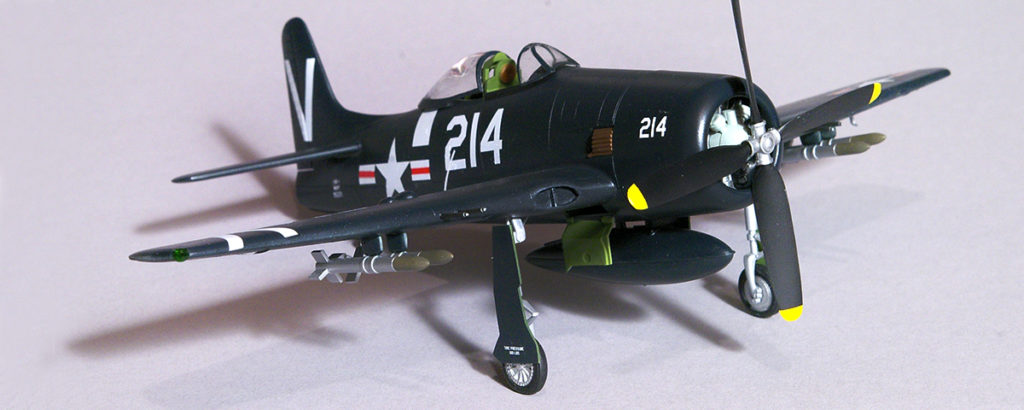The Grumman F8F Bearcat is the Dodge Viper of airplanes. Both are outrageous, lightweight, in-your-face- American, monster-motor artifacts of fast-disappearing eras, designed on the cheap and produced quickly. The car/airplane comparison even extends to the fact that both have what might be considered truck engines: the Viper a V-10 originally intended for big Dodge pickups, the Bearcat an 18-cylinder, 2,250-hp radial (in the F8F-2) that some fighter purists would consider a “bomber engine.”
Like a Viper, the Bearcat was about as utilitarian as a funny car. It couldn’t carry much, couldn’t go far, was uncomfortable, super light, loud as hell and had just one mission in life: to be fast and agile. “No missiles, no radar, just a nasty, mean little street fighter with an attitude,” as Commemorative Air Force Bearcat demo pilot John Deakin puts it.
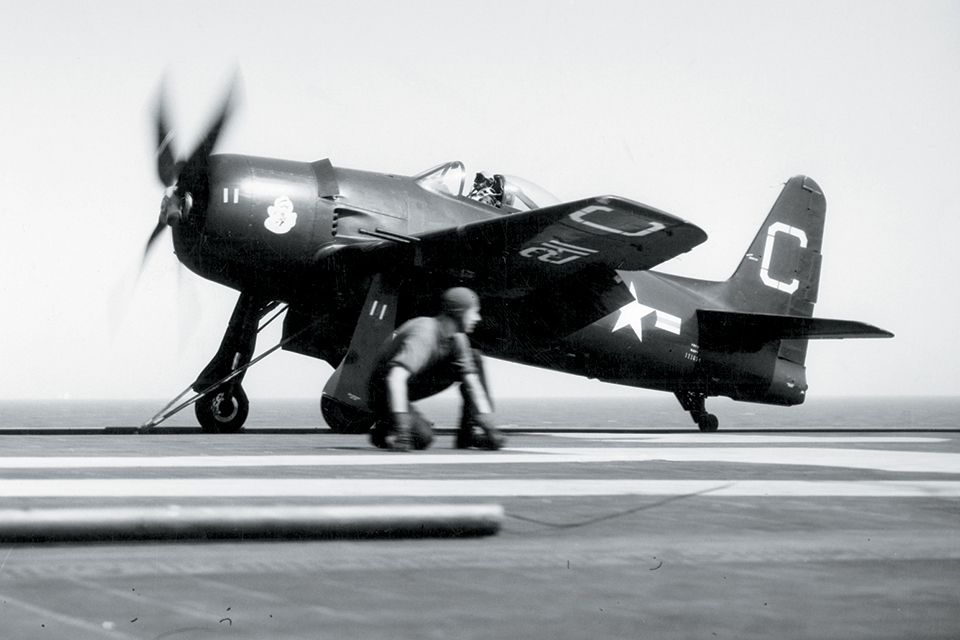
But even before the big Dodge sports car existed, there were automotive comparisons to the Bearcat. Said one 1950s Navy pilot, “The Hellcat was a Buick, the Corsair a Cadillac, but the Bearcat was a Maserati.” Another likened it to a Harley-Davidson, a classic celebration of Yankee excess. And to revert to an even earlier transportation era, a third tailhooker called the Bearcat “an engine with a saddle.” He wasn’t kidding. The Pratt & Whitney R-2800 engine weighed about 3,000 pounds, and the airframe behind it totaled 4,000 empty. To say a Bearcat was half engine isn’t much of an exaggeration. “Pretty hard to strap a bigger engine on a smaller airframe,” Deakin points out.
The F8F was designed as a special-purpose airplane, to simply launch, climb like a rocket and intercept incoming Japanese aircraft. Into a typical over-the-deck headwind, a Bearcat had a 200-foot takeoff roll, less than two-thirds of an F6F Hellcat’s, and even on a landlubber’s runway it was difficult to get the throttle two-blocked before liftoff. The Bearcat carried little fuel but didn’t need much for this mission, and it had a rate of climb unequaled until the jet age; it could do nearly 6,400 feet per minute to 10,000 feet. But contrary to one Bearcat myth, it wasn’t designed as a kamikaze-killer, since the first true Japanese suicide planes didn’t strike at Allied ships until October 1944, when the Bearcat was already well into its flight test program.
The Bear was late to the party nonetheless. The first F8F air wing arrived in the Pacific theater literally days after the war ended, and the Bearcat was never to see combat in U.S. hands—not even in Korea, where its relatively basic armament wasn’t good enough for strafing and the longer-legged F4U Corsair was judged to be a better fighter-bomber. The French, however, did use Bears as mud movers during their Indochina war, the only time Grumman’s last piston-engine fighter ever saw combat. (As a young merchant seaman in the mid-1950s, I saw a pile of wrecked C-47s and F8Fs on a wharf in Saigon, waiting for shipment to who knows where. An airplane nut in bell-bottom dungarees, I snuck through the rows of battered aluminum until I found myself on the wrong end of two automatic weapons in the hands of South Vietnamese soldiers, but it was my very first contact with a Bearcat.)
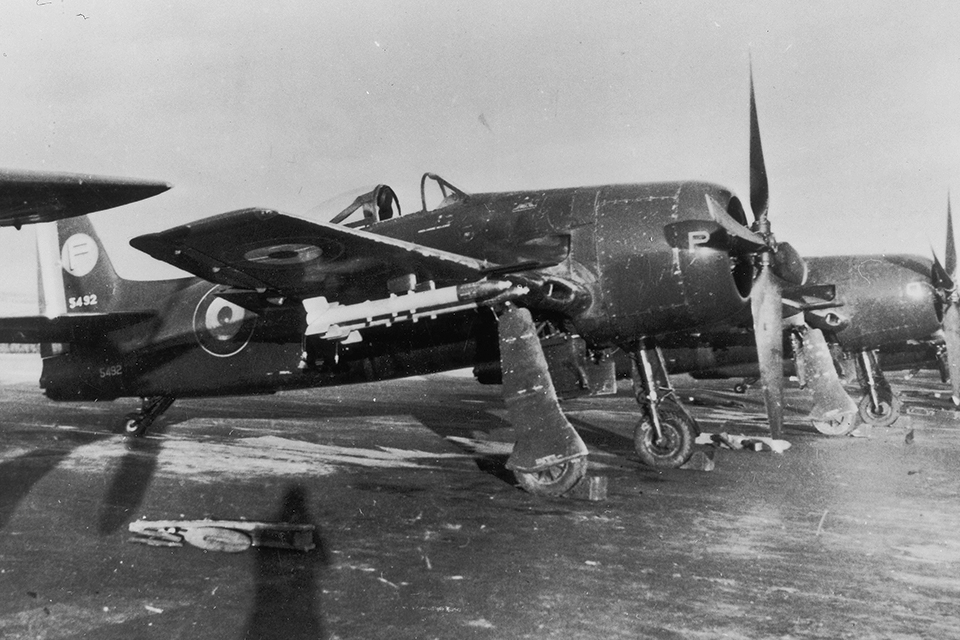
Ultimately, not a single Bearcat ever performed the mission for which it had been designed—air-to-air combat—whether in the hands of the U.S. Navy and Marines, the French, the South Vietnamese or the Royal Thai Air Force. Nobody will ever know what kind of air superiority fighter it might have been, and it remains one of the 20th century’s great what-if aircraft. (“What if a Bearcat and a Kawanishi Shiden-kai had ever faced off? What if a Bearcat and a Focke-Wulf Ta-152…a Bearcat and a Hawker Sea Fury…” and so forth on every Internet warbird forum.)
Still, the Bearcat was particularly loved by pilots. Neil Armstrong famously once said it was his favorite airplane, and the widely warbird-experienced Deakin agrees: “The Bearcat is my personal favorite. Handling, power-to-weight ratio, and all of it in a package that’s pleasing to the eye. It looks like a muscle machine, and it is.” British test pilot Captain Eric Brown, who has flown more aircraft types (487) than any other pilot in history, has 20 favorites that he’s tested, and only one American prop-driven fighter appears on the list—the Bearcat.
Steve Hinton, one of the world’s most experienced warbird pilots and racers, says, “Oh, yeah, it’s my favorite airplane to fly. If you add up all the qualities of the airplane, it comes out on top. The speed, the ease of flying it, control feel, the rate of climb is spectacular…it’s pretty exciting. As far as flying qualities and looks go, it’s number one.”
Recommended for you
Another enduring legend about the Bearcat is that its design was inspired by the Focke-Wulf Fw-190, and that many of its features were copied from the German fighter. Some even claim that Grumman had a Focke-Wulf at its Bethpage airfield on Long Island, N.Y., and that Grumman test pilots flew it there, which is not true.
Grumman pilots did fly a captured Fw-190 in England in September 1943, according to former Grumman test pilot Corky Meyer, and again at the Navy’s Patuxent River test facility the next year. But the Bearcat’s specific parameters had already been laid down in considerable detail in July 1943, two months before any Grumman pilot or engineer had ever seen a Focke-Wulf. It would seem that the chronology makes it impossible for the Bearcat to have been inspired by the Fw-190.
“I suspect that this is either an outright urban legend or a story with some small grain of truth,” says aviation historian Richard Hallion, who makes the case that development of the Bearcat was simply a legacy of the Navy’s encounter with the light, agile Mitsubishi A6M2 Zero. As a result of Grumman F4F Wildcat/Zero combat, the original Hellcat “was completely redesigned as a much lighter and more powerful airplane,” Hallion says, “hence it first appeared in service in 1943 as the F6F-3, not the F6F-1. The Bearcat represented what squadron pilots really wanted even in 1942: high power-to-weight ratio, small, agile, sufficient armament and optimized as a dogfighter.”
The Bearcat and Fw-190 were very close in size—something that could be said of many fighters—and both had radial engines. Beyond that, there are no important parallels or similarities, and to say the German land-based fighter inspired creation of the U.S. carrier-borne fighter would require the preposterous assumption that Grumman engineers were unaware of the benefits of light weight, agility and a high power-to-weight ratio and needed to fly a German airplane to discover those qualities.
Yes, certainly the Grumman pilots’ stick time in the Focke-Wulf would have shown them that the company was on the right track in building a small, mean, uncomplicated fighter, but there was nothing Leroy Grumman or Bill Schwendler needed to learn from the Germans. Thompson Trophy raceplanes of the 1930s had already made it clear that putting the biggest engine in the smallest airframe produced high speed, and it was no coincidence that Robert L. Hall was one of the two Grumman pilots to fly the Focke-Wulf. Hall had worked for Granville Brothers Aircraft and participated in the design of the Gee Bee Model Z, the first of several barrel-bodied Granville racers. Hall left Granville to design and race his own Thompson competitor, the Hall Bulldog, a big-engine/small-airframe gullwing design that looked a bit like a high-wing Gee Bee.
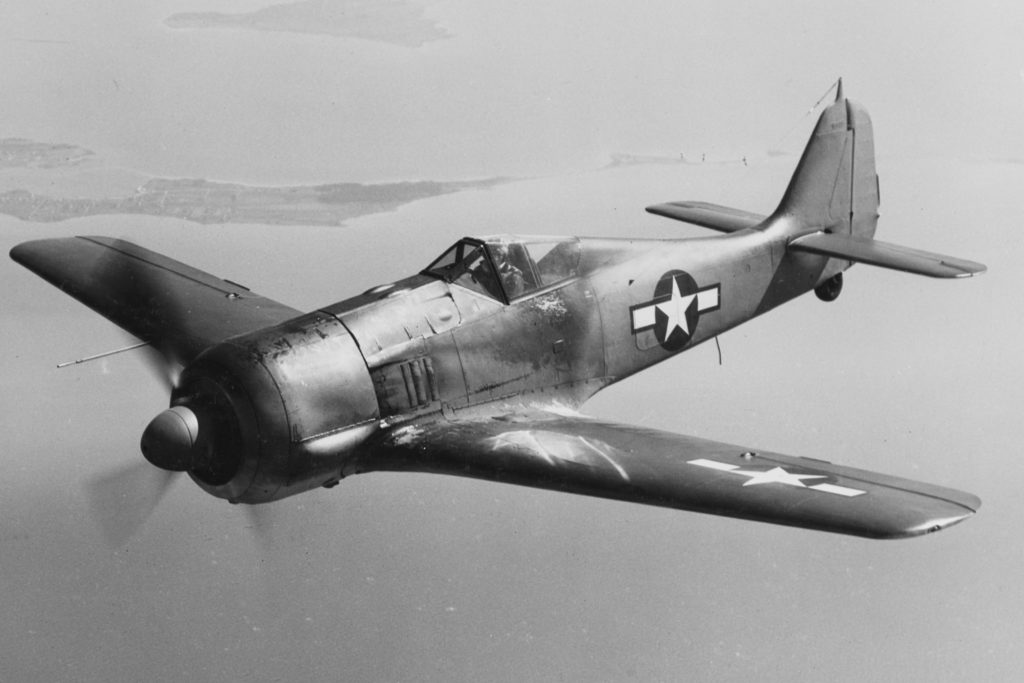
The Focke-Wulf legend has it that Hall, “Grumman’s chief engineer,” rushed back to Bethpage to design the Bearcat, and he’s sometimes even referred to as “the Father of the Bearcat.” In truth Hall was the assistant chief engineer experimental and a test pilot, and if anybody was the Bear’s daddy, it was Chief Engineer Bill Schwendler.
Flying the Focke-Wulf would certainly have shown Hall that the distinctive humpbacked outline of the Bearcat’s fuselage would be a benefit, for the one thing Grumman pilots found lacking in the 190 was a good view over its nose for finding, tracking and leading gunnery targets. F8F pilots had a splendid forward view, sitting somewhat above the big radial engine’s cowling—not a bad thing for carrier landings, either.
On July 28, 1943, with Hellcat production pretty much taking care of itself, and F7F Tigercat design and engineering nearing completion, Roy Grumman proposed a Hellcat successor. It was to use the F6F’s R-2800 engine, be roughly the size of a Wildcat, weigh no more than 8,500 pounds with full fuel and be armed with just four .50- caliber Brownings, which were thought to be quite adequate for downing the lightly armored Japanese Zippos. (Fighter pilots always want more, so a number of later-production F8F-1s and all the -2s were fitted with four 20mm cannons in place of the machine guns.) The 8,500-pound weight criterion was soon changed to 8,750, but Grumman still never quite made it, and the basic airplane ended up at 8,820 pounds wet; stressing an airplane to withstand carrier landings and tailhook snubs inevitably adds weight.
“It was one of the first fighters designed for lightness,” Hinton says. “Typically, [fighter engineers] just built the hell out of ’em, because they really didn’t know what they were up to. But Grumman went out of its way to save weight, and the airplane’s speed actually came out 40 miles an hour over spec.”
Roy Grumman also stipulated a full-vision bubble canopy, a first for a Navy fighter. Such canopies were a British invention, a product of their Battle of Britain combat experience. The Army Air Forces soon adopted them for most P-47Ds and the P-51D, but oddly the Navy never used them in World War II. The Bearcat and the Goodyear F2G Super Corsair, of which only 10 were ever made, were the sole Navy piston-engine fighters to have full-vision hoods. (The Ryan FR-1 Fireball had a semi-bubble, with the aft third all metal.)
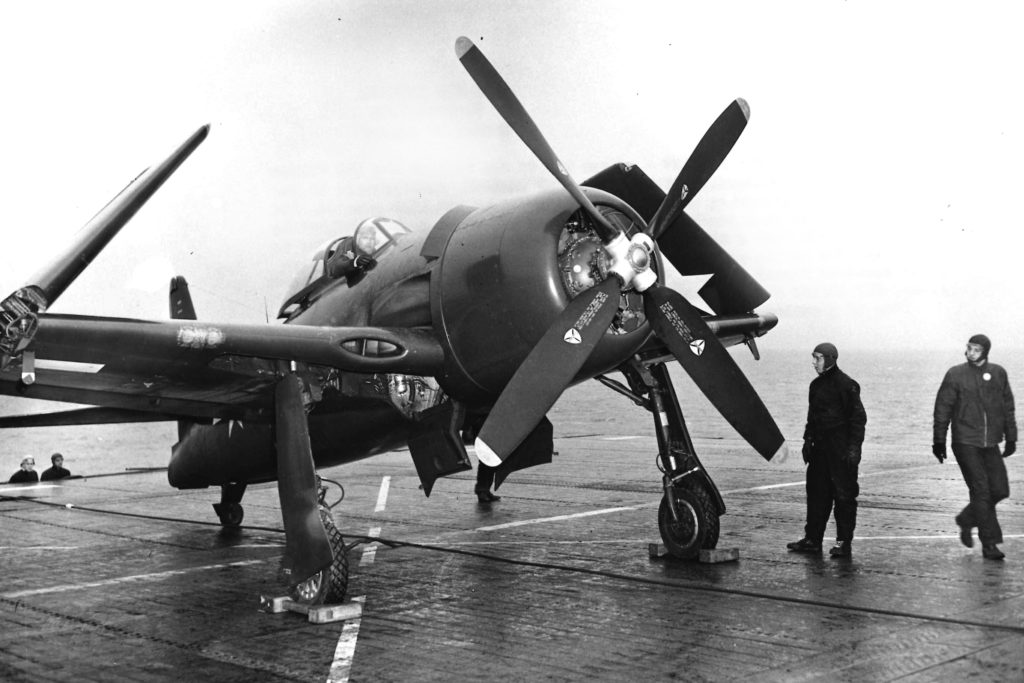
Grumman wanted the new fighter to be as light and simple as possible, and this led to another Bearcat myth—that it was intended to operate from small escort carriers and therefore was a Wildcat replacement, since F4Fs remained in the jeep carrier air wings even well after the big F6F came into the fleet. This misunderstanding devolved from the fact that Roy Grumman added a codicil to his Bearcat memo, warning Schwendler that “In order to check Bureau [of Aeronautics] tendency to overload, this design should be sold as a ‘converted-carrier’ fighter.” Converted carriers were CVEs, often merchantman hulls that had been flat-topped as escort carriers, and Grumman knew if the Navy realized he intended this new design to operate mainly off big CVs, BuAer would demand more guns, gas tanks, fancy systems, bigger wings and the like, and soon the company would be building a 12,000-pound limo rather than the hot rod it wanted.
Despite worries about BuAer, in 1943 that office was staffed by at least some Navy desk pilots who’d had their tickets punched flying light, maneuverable Boeing and Grumman biplane fighters in the 1930s. They loved the F8F concept: a Hellcat Lite, a Hellcat Hot Rod, a minimum-weight/maximum-performance, short-legged stripper designed to fill an air superiority gap that, it was presumed, might open when the Japanese fielded their next generation of 2,000-hp, post-Zero navy fighters, which in fact never materialized.
In pursuit of lightness, Grumman not only limited the F8F’s fuel load and armament, it also dispensed with nice-but-not-necessary systems such as powered wing folding and hydraulic tailhook retraction. After a Bearcat deck-landed, aircraft handlers lifted the tailhook back into place, then folded the wings by hand, sticking a big prybar into a socket under the folding wing panel and using leverage to muscle the wing straight up and a bit inward. Nor was there even a prop spinner, which gave the Bearcat its characteristic face, like a prizefighter whose nose had been mashed once too often. The enormous AeroProducts four-blade prop carried a dedicated oil supply that altered prop pitch in a doughnut-shaped tank behind the propeller hub. This meant there wasn’t even the usual distinctive mini-spinner dome ahead of the hub, which on conventional constant-speed props held the mechanism to dispense engine oil to the blade controls.
That 12-foot-4-inch propeller—only a foot smaller in diameter than the far larger and heavier F4U Corsair’s enormous prop—required extremely long main gear legs for ground clearance. Even so, Bearcats typically lifted off and landed in a nose-up attitude to avoid prop strikes. “It’s very easy to ding a prop, and it’s a rare one,” says Deakin. “It would almost certainly today mean a switch to a modified prop from another airplane, and possibly an engine swap to accommodate it. We [the CAF] have a lot of trouble with the prop, due to no parts being available.”
“These fighters are all designed to take off that way,” explains Hinton. “It’s actually easier to just let the airplane accelerate and take off already in a climb attitude than it is to push the tail up. Trim it up, put the power to it and there’s very little torque effect when you take off tail low. If you get the tail up, you’re fighting gyroscopic P-factor.”
The gear legs were unusual in having a pivot point about a foot below the main gear-to-wing trunnion. Upon retraction, the upper portion of each gear leg would fold outward while the rest of the strut retracted inward, toward the fuselage. The wings, with the same NACA 230-series airfoil as the F6F, were just big enough to carry four guns, two wheel wells, flaps and a few cables. There were no wing tanks, just a single 185-gallon fuel tank behind the cockpit. One unusual extra was a pair of small dive-recovery flaps just behind the wheel wells. Like the Lockheed P-38, which pioneered dive flaps, the Bearcat could go downhill so fast that transonic shock waves would develop, immobilizing the ailerons and making recovery impossible. Deploying dive-recovery flaps backed the airplane out of this danger zone and at the same time added a pitch-up moment to aid recovery. On the Lightning it happened automatically; in line with the Bearcat’s simplicity, its dive flaps had to be manually deployed.
If the Bearcat had a vice that could catch new pilots, it was that “it’s easy to overstress it,” Deakin says. “Contrary to the opinion of most, the airframe is not highly stressed—strong enough, but not as rugged as it looks. This might have made it poor in actual combat, but we’ll never know.” Hinton agrees, pointing out that the Bearcat is “an airplane that can lure you into a false sense of security. Early in its career, the Bearcat went right into training squadrons, since the jets were right around the corner. So they had a lot of new guys flying these things, going really fast, pulling a lot of Gs, and they did have problems, including hard deck landings that transmitted into issues with fatigue and wings coming off.”
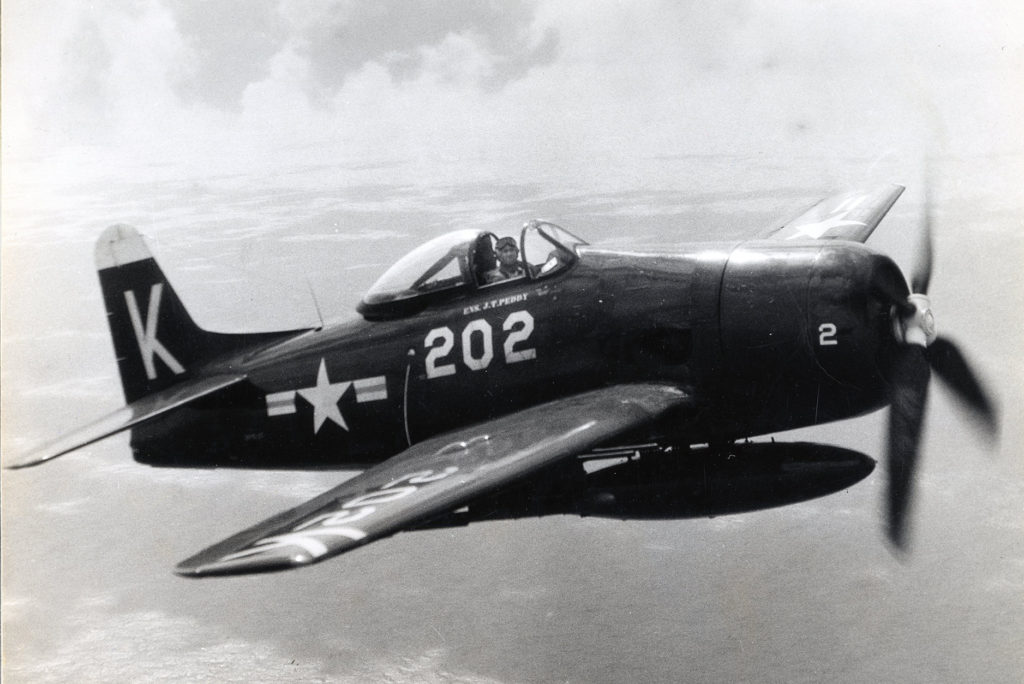
Bearcats had no air conditioning, so pilots learned to dress as lightly as they could. They were sitting behind an 18-cylinder furnace, their feet inches from the firewall and the engine’s accessory section, under a Plexiglas solarium. Nor was that seat adjustable, since the necessary mechanisms and fuselage strengthening would have added weight. Pilots used cushions (and of course their seat-pack parachute) to adjust their seating positions. The starting drill required the canopy to be closed no matter how hot it was, since the big radial’s exhaust pipes were ideally positioned to spit an oil mist into the cockpit on startup. Some production Bearcats had a “windscreen degreasing control” that sprayed an oil-dissolving solvent to clean off the usual mess.
One of the Bearcat’s most unusual weight-saving measures was its “Safety Wing Tips,” which was the positive-spin wording that Grumman put on this strange feature. Grumman engineers figured that if the airplane’s wingtips could be designed to torque off if nine Gs was exceeded in a combat pullout, the wing inboard of that juncture could be built more lightly yet would still support a 13G ultimate load, since the full wing would not be required to carry that load. Sounded like a good idea at the time, as they say.
One problem was that both wingtips should go simultaneously, though flight testing showed that the Bearcat flew pretty well with just one wingtip and half of its aileron gone. The airplane was actually so overpowered that it probably would have flown at least a short distance with no wings. Tests also made it plain that the Bearcat flew just fine without the outer 3 feet of both wings, and could be carrier-landed in such a configuration. Many Bearcat sources, both published and online, claim that the zipper was not 3 feet from the tips but shed the entire 6 feet of each wing that folded for carrier storage. Which seems reasonable other than the fact that it would have left a Bearcat with no ailerons. Not a good idea.
So Grumman tested a prototype with explosive primer cord wrapped inside each wing to blow each of the tips off roughly simultaneously. Which ever one severed first from the G loads during a test dive would send a signal via a microswitch to the opposite tip for the primer cord to blow it off as well. Grumman insiders referred to it as the “ice-box switch”—like the one that turns off the light when you close the refrigerator door—an indication of how small that switch actually was.
That worked just fine, though the shrapnel made chase plane pilots flinch during testing, so Grumman began to build Bearcats with explosive bolts—and, assumedly, ice-box switches—to shed wingtips when necessary. An earlier crash after an asymmetric tipshedding dive pullout, plus an incident where a Bearcat killed a ground crewman when a wingtip blew off inadvertently, led to a “more trouble than they’re worth” decision by Grumman, and the wings were made solid and the airplane’s G limit lowered. Some claim the Safety Wing Tips were a great idea that Grumman simply didn’t have time to engineer properly under the press of wartime deadlines, but the fact remains that nobody in the six decades since the Bearcat was built has bothered to seriously revisit the concept.
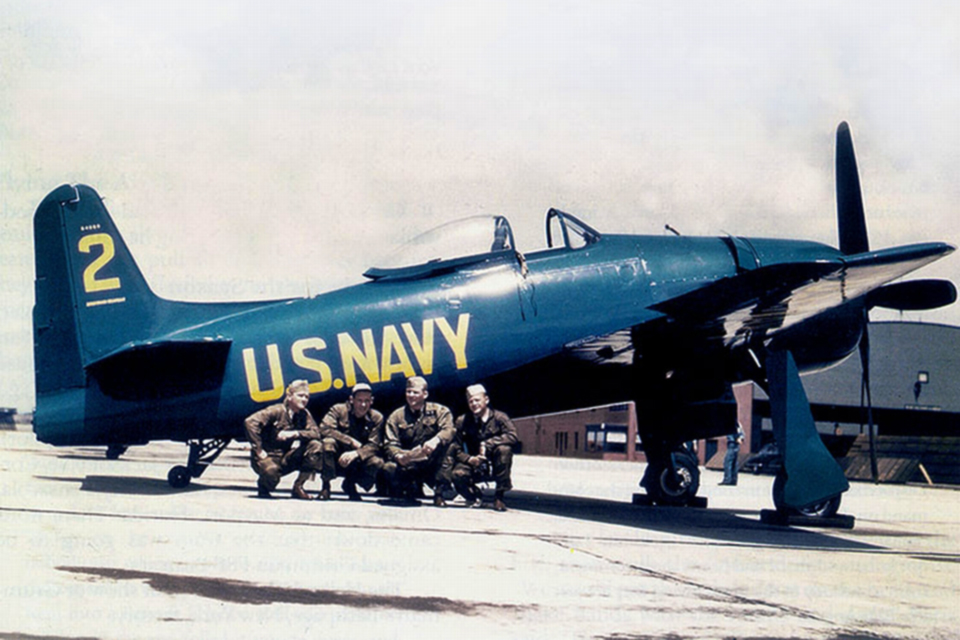
Grumman tried to turn some modified Bearcats into night fighters, but that didn’t work either. There wasn’t room on the wing leading edge for a faired-in radome blister outboard of the guns and inboard of the wing fold, so the radar unit had to be carried in an awkward tank under the right wing.
The combination of small wings and asymmetry made the airplane difficult to handle. It was, of course, widely assumed that the U.S. would have to invade Japan, and Bearcat production was about to ramp up to protect the invasion fleets, but before any of that could happen, the atomic bomb put an end to the war on August 15, 1945.
Two civilian Bearcats were built after the type’s production run was complete—registered as G-58As, not F8Fs, since they were assembled largely from mix-and-match parts left over from production and thus matched no known Bearcat version. One went to airshow pilot and Gulf Oil PR man Al Williams, who had since the late 1930s flown a series of civilianized fighters he called Gulfhawks. His Bearcat was the Gulfhawk IV. Williams flew it at airshows demonstrating…well, who knows what? (Imagine Bob Hoover today asking for an F-16 with which to replace his P-51.) After flying it for less than two years, Williams destroyed the Gulfhawk IV when a gear leg collapsed on landing; the airplane sat heavily on its centerline belly tank, and the remaining fuel ignited and torched the aircraft.
The other G-58A Bearcat is invariably described as the “Grumman demonstrator,” but in fact Grumman had no need for a sales department airplane. It was actually built to the order of (and paid for by) Grumman VP Roger Wolfe Kahn, the most multitalented aviation exec of his time. Kahn was the son of investment banker Otto Kahn, and he became a widely acclaimed jazz bandleader in the 1930s. He and Otto were the first father and son to both be the subject of Time magazine cover stories for entirely different reasons.
Roger Kahn ended up at Grumman, where he achieved far less notoriety but is still known in the aviation maintenance community as the developer of the original tech-rep system whereby complex military devices are today routinely supported by civilian factory technical representatives. Several Grumman pilots used Kahn’s Bearcat to deliver crucial parts to F8F squadrons all over the country.
In the spring of 1946, the Navy borrowed an Army Air Forces Lockheed P-80 jet and sent an F8F-1 up to rat-race with it. Both fliers were combat-experienced, but the Bearcat jock couldn’t get a shot in edgewise. The P-80 literally ran rings around him, and of course had the speed to engage and disengage at will. As historian Hallion later wrote, “That mock dogfight high over Patuxent River spelled the death of the piston-engine naval fighter. The chief of the Bureau of Aeronautics down to the lowliest ensign in the most obscure fighter squadron realized that the Navy had to develop carrier-based jet fighters in order to stay in the air combat business.”
It is sometimes written that “the Bearcat was the equal of early jets,” which is nonsense unless you’re matching it solely against the Bell P-59 or the pitifully underpowered original McDonnell FH-1 Phantom. After less than a year of operational service, the Bearcat was damaged goods, no longer able to do the job for which it had been designed. It was replaced by Grumman’s own F9F-2 Panther and the McDonnell F2H Banshee—simple, primitive, low-powered jets but still far more combat-capable against a new generation of adversaries than America’s last-ever piston engine brute.
Still, the Grumman Bearcat wasn’t quite finished yet. Its roar would resound on the racing circuit in decades to come.
World’s Fastest Piston-Engine Airplane
Ultimately, the Grumman F8F made real history. Not as a weapons system, not as a Blue Angels aerobat (which it was from 1946 through 1949), not as “the ultimate piston-engine fighter” (a title often claimed by Bearcat enthusiasts but easily contested by fans of the even more powerful and faster Hawker Sea Fury), but as the holder of a world speed record: In 1989 the modified Bearcat Rare Bear flew a Fédération Aéronautique Internationale–attested 528.329 mph, faster than any piston-engine aircraft had ever flown.
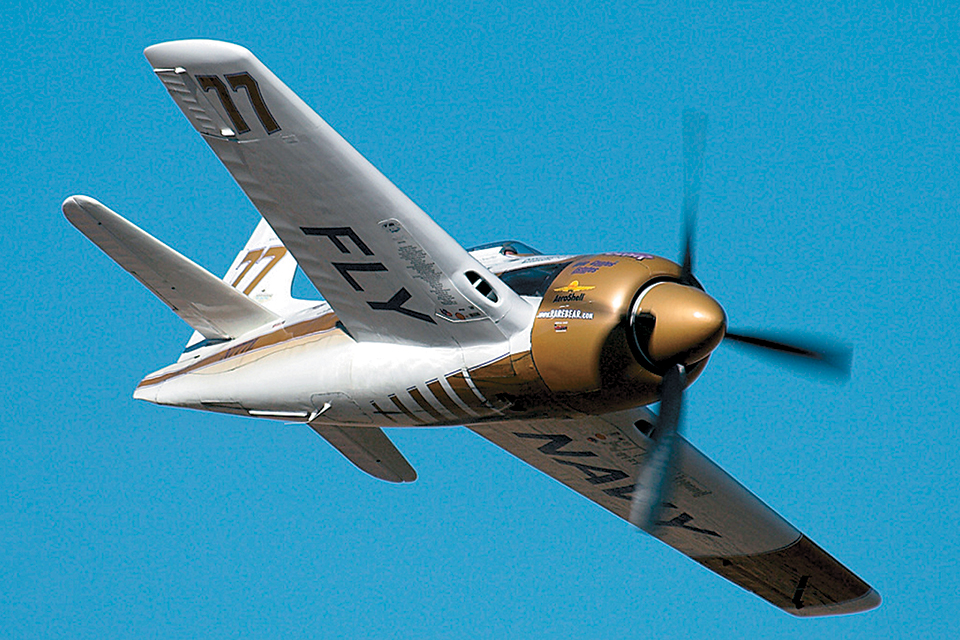
The only ex-Navy air racers that flew in the late 1940s and ’50s were Corsairs, since Bearcats weren’t yet being sold to civilians. In 1964, however, three Bears showed up at the Reno Air Races. Mira Slovak won with one of them after Darryl Greenamyer was disqualified for refusing to land, after the race, at the dirt strip race site. Greenamyer’s Bearcat went on to win in Reno from 1965 through 1969, then again in 1971.
Greenamyer’s Grumman was the first Unlimited racer to be seriously modified, at a time when other competitors were simply warbirds with snappy paint jobs and lightly tuned engines. It had clipped wings, sealed flaps, a big prop spinner covering the Bear’s pug nose and a tiny bubble canopy that had originally been a Lockheed Neptune patrol bomber’s searchlight fairing. In 1965 it also got a more powerful version of its original R-2800 engine, turning a four-paddleblade prop from a Douglas A-1E Skyraider. Greenamyer, a Lockheed SR-71 Blackbird test pilot, became intrigued by the thought of breaking Fritz Wendel’s ultimate piston-engine speed record, set at 469.22 mph in 1939 in a special Messerschmitt Me-209V-1. In 1969 he raised it to 482.462.
That same year, Lyle Shelton began to refine another Bearcat, which would become Rare Bear. He installed a 2,700-hp Wright R-3350 engine from a Skyraider with a four-blade prop from a DC-7, later changed to a wide-blade prop from a Lockheed P-3 Orion turboprop, and eventually had the power plant tweaked to put out more than 4,000 hp. It was the first Unlimited racer to undergo a total make-and-model engine transplant, and with it Shelton, and then John Penney, won the Reno Races nine times between 1973 and 2007. In 1972 Shelton’s modified Bearcat broke the world 3,000-meter time-to-climb record with a time of 91.9 seconds—a record it still holds—and in 1989 set the ultimate piston-engine speed record. [Editor’s note: That record has since been broken by Steve Hinton Jr., who on September 2, 2017, flew the highly modified North American P-51D-25NA Mustang Voodoo to an average speed of 531.53 mph.]
A former executive editor of Flying magazine, frequent contributor Stephan Wilkinson writes from Cornwall-on-Hudson, N.Y. Further reading: Grumman F8F Bearcat, by Corwin Meyer and Steve Ginter, and Racing for the Gold: The Story of Lyle Shelton and the Rare Bear, by Dell Rourk.
Originally published in the May 2010 issue of Aviation History. To subscribe, click here.
Want to add a Bearcat to your collection? Click here and build your own!

